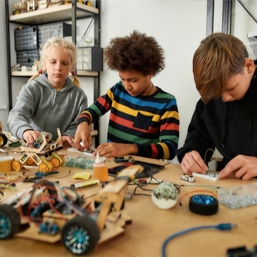
When your electronic gadgets break, does your tween fix them? Do you have a child that builds elaborate housing for pets and dolls out of scraps of craft materials and cardboard boxes? Maybe you’re raising entrepreneurial teens with ideas that could make them the next Facebook or Snapchat inventor, app creator, or Shark Tank winner.
If any of this sounds familiar, you may have a ‘Maker’ on your hands. But what exactly does that mean?
What is the Maker movement?
The Maker movement is a quickly-growing culture that embraces the idea that learning is done best through doing. “It includes do-it-yourself individuals and groups that create things, and its members are producers more than consumers,” says Irm Diorio, executive director of a Maker space. While some Makers work in Maker spaces, others tinker in their homes and garages. Some Maker interests include robotics, electronics, metalworking, woodworking and traditional arts and crafts.
With increasingly affordable access to 3D printers and computers, technology is often a part of the Maker movement, but it doesn’t have to be, says Irm.
“Everyone is a Maker,” Irm says, and she encourages others to discover the Maker in them. “It’s about finding what really inspires you – gardening, baking, sewing, anything that you would build with your hands. It’s fun and can be functional, but it doesn’t have to be. It’s all about letting your creativity take you for a ride.”
Why do Makers use Maker spaces?
Some Makers discover their community at Maker spaces, where adults and children find the community and supplies they need, including equipment and tools that are hard to store at home. Maker spaces often house equipment like 3D printers, laser cutters, wood lathes, saws, welding equipment and sewing machines. Maker spaces offer community, encouragement and expertise for those working on projects. Maker spaces are also becoming popular in schools because parents, teachers and administrators want to include this creative outlet in the learning process.
How can parents support a Maker-minded life?
How you help your child flourish at being a DIY kid depends on their age. Here are some suggestions that will help guide kids as they grow.
Preschool:
Elementary:
Jr. High and High School:
Janeen is a nationally published writer, teacher and mom to Andrew and Gracie.
Online resources for the Maker-minded family
See our related articles:
Calgary’s Child Magazine © 2024 Calgary’s Child